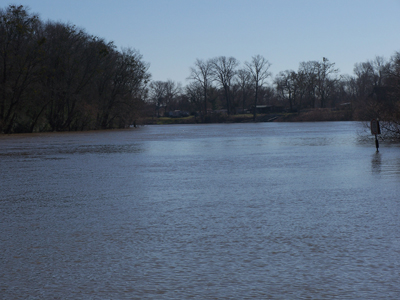Roanoke River
Roanoke River is formed in the Blue Ridge Mountains in Montgomery County, Va. by the junction of North Fork and South Fork; it then flows southeast into Warren County, N.C., north of Roanoke Rapids. From there it travels along the Halifax-Northampton, Halifax-Bertie, Bertie-Martin, and Bertie-Washington County lines into Batchelor Bay in the Albemarle Sound. The Roanoke River has appeared under a variety of names in North Carolina history, including Morattico River in 1657 and Noratake River in 1671, but Edward Moseley wrote the name ‘‘Roanoke River’’ on his map of 1733. The river was a source of water for the early settlements in Virginia, North Carolina, and South Carolina.
The Roanoke is dammed several times along its course to form a series of reservoirs. In northeastern North Carolina, the river is impounded to constitute the Lake Gaston reservoir, which stretches north and reaches the John H. Kerr Dam in Virginia, which forms Kerr Lake. Other reservoirs include the Smith Mountain Lake and Leesville Lake. The size of the Roanoke’s North Carolina watershed is 3,600 square miles; the total length of the river is about 410 miles. The river basin encompasses 37 municipalities in the state, including Henderson, Halifax, and Williamston. In the early 2000s the region had a population of more than 275,000. The Roanoke has benefited from conservation efforts by the Nature Conservancy, the North Carolina Wildlife Resources Commission, and other agencies and private organizations. It remains a vital habitat for large numbers of fish, birds, and mammals as well as a principal recreational area for North Carolinians and visitors to the state.
Reference:
Garnet Bass, "Roanoke's Dazzling Diversity," Wildlife in North Carolina 63 (November 1999).
Image credit:
Hairr, John. 2005. "The Roanoke River near Weldon in Halifax County."
1 January 2006 | Bayley, Elizabeth
 by Elizabeth Bayley, 2006
by Elizabeth Bayley, 2006